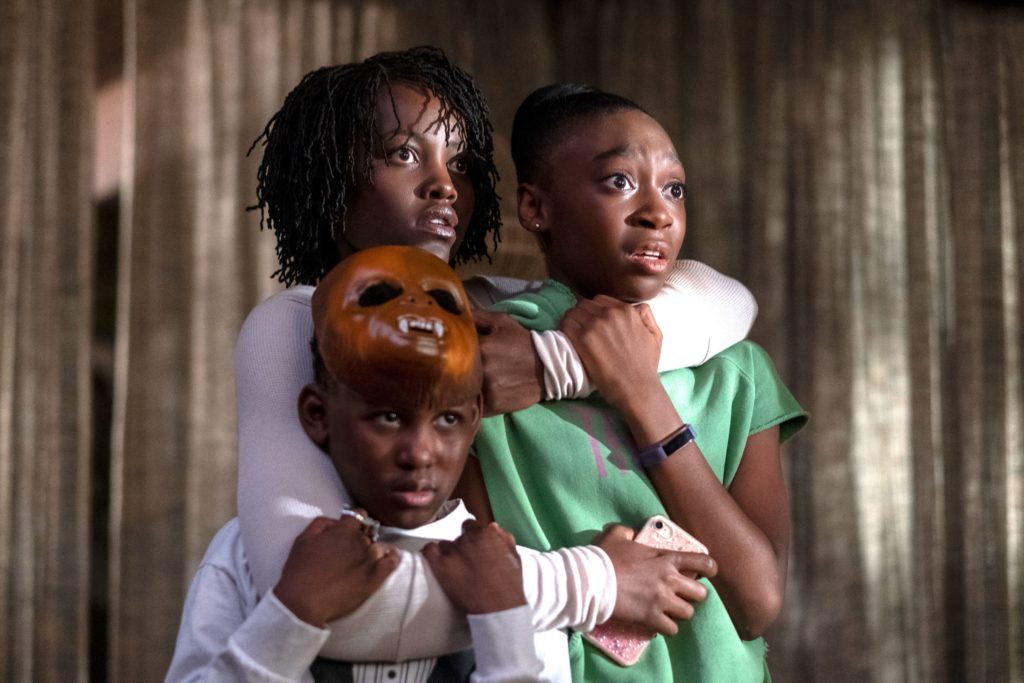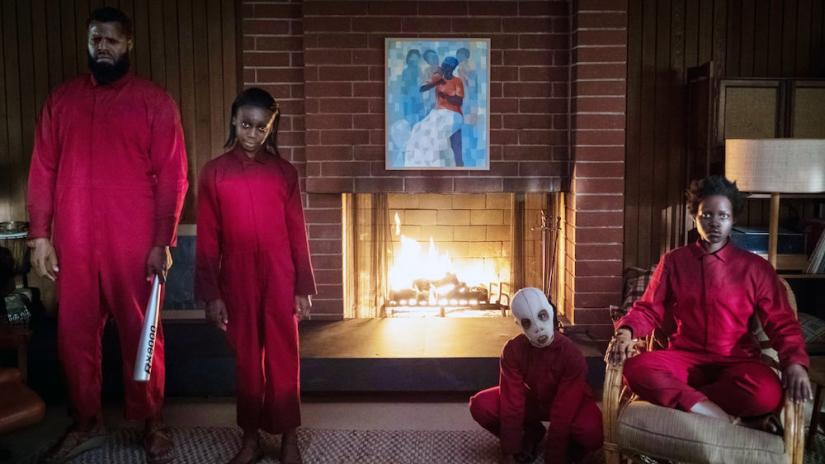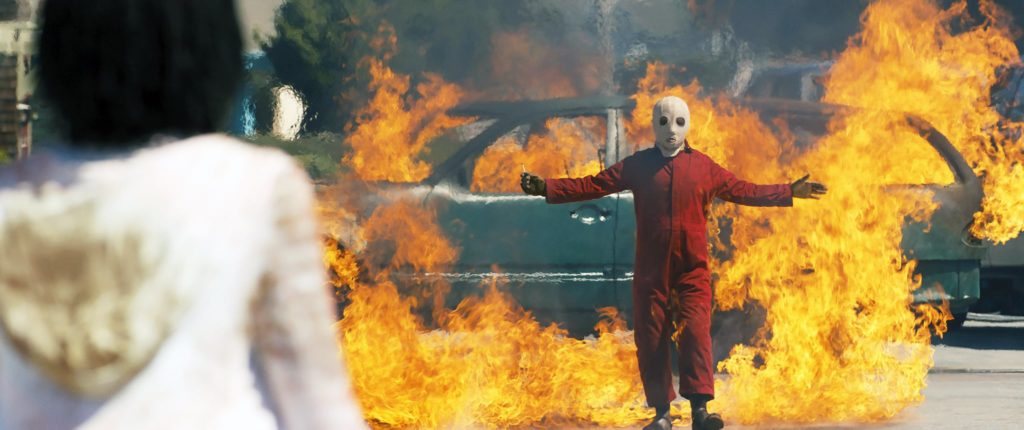
Jordan Peele’s Get Out was such a unique and exhilarating blend of images and ideas—a suspenseful horror movie with a pointed political message—that it was easy to tolerate its third-act slide into ordinariness. His follow-up, Us, is not quite as thematically bracing; it feels more like a superlative exemplar of nightmare cinema than a full-on reinvention of the form. But even if Us is more entertaining than extraordinary—and to be clear, it would be deeply unfair to demand that Peele’s encore be equally groundbreaking—it is in some ways a more impressive picture than Get Out, with superior visuals and more consistent follow-through. Minimizing sociopolitical allegory in favor of visceral dread, it finds Peele sharpening his focus and refining his technique. He’s less interested in making you look inward in self-reflection than in forcing you to shut your eyes in fear.
This isn’t to say that Us is altogether silent with respect to race and politics. Its vision of an unseen underclass—a toiling horde of perpetually neglected laborers, à la The Time Machine—isn’t all that far removed from Get Out’s conceit of white aristocrats bidding on black bodies. But the most striking overlap between the two films is their use of the same indelible image: a close-up of a central character’s face, eyes widening in dismay and filling with tears as they perceive the terror of what surrounds them.
They have a lot to be afraid of. With exquisite patience and precision, Peele constructs Us according to durable horror templates while simultaneously imbuing it with sufficient detail that prevents it from feeling overly familiar. And so, there is an incredibly creepy prologue in which a child wanders into a spooky place (here, a hall of mirrors, because can it get any spookier?) and finds herself confronted with an unknown evil. There is a remote house nestled in the woods, an isolated location that is prime real estate for cinematic peril. There’s a scary-looking dude with long hair and bloody fingernails holding a sign inscribed with a Bible verse. There are silent figures clad in dark red uniforms who stride forward with ominous purpose. There are burning cars, broken limbs, and several pairs of scissors that seem less designed to cut paper than skin.

None of this is especially revolutionary, but Peele invests it with an urgency that makes it feel vital. Yet despite the constant specter of violence, mayhem, and death, Us is also oddly enjoyable. Peele’s films traffic in disturbing stuff, but he isn’t a sadist, which means that he largely eschews the jolt scares that popularize so much schlocky modern horror. If you like regularly leaping out of your seat in response to fleeting moments of Conjuring-style shock, you may chafe at Us’ silky camerawork and simmering suspense. For my part, I prefer hunching forward in anticipation, and while Us is far from the scariest movie to hit theaters in recent years—it lacks the relentless foreboding of Hereditary or the omnipresent dread of It Follows or the lurking nightmares of The Babadook—it is a thoroughly engrossing experience, drawing you in with its colors, its mysteries, and its music.
Speaking of which: In another nervy move, Michael Abels’ score appropriates Luniz’s “I Got 5 On It”—particularly the grace notes of its bassline—and converts it into de-facto theme music, akin to the bells of The Exorcist or the piano of Halloween. Those fluid thumps mesh nicely with Peele’s sly command of horror tropes, in particular the way he loads the film’s first act with seemingly mundane objects—a Matchbox car, a cigarette lighter, a finicky motor—that eventually become pivotal instruments of salvation and destruction. (Also, there are lots of rabbits, and between this movie and The Favourite, you will never look at a cute bunny the same way again.) He also fixates on mirrors, watching his characters as they watch themselves, searching for imperfections.

And of course, it is this notion of flawed reflection—self-portraits that are distorted, cracked, broken—that powers Us’ plot as well as its themes. As its trailer perhaps unwisely disclosed, the film follows a family of four—the parents are played by Lupita Nyong’o and Winston Duke (Black Panther), their children by Shahadi Wright Joseph and Evan Alex—whose placid summer vacation is suddenly interrupted in the black of night when a quartet in matching attire breaks into their home. The kick: The intruders are in fact the family’s own doppelgängers, twisted versions of themselves who seem bent on kidnapping and murder. Are these glowering invaders simply monsters? Or are they monstrous glimpses of our main characters’ worst selves, demonic incarnations of their own repressed darkness and cruelty?
These questions have no clear answers, which is to say they have a million of them. By its nature, Us invites speculation and debate; it is also sure to reward repeat viewings, where rabid theorists can scour its frames for clues and connections. Yet for all its intrigue and implications, the movie doesn’t possess a ton of heft. The doppelgängers are more chilling as purveyors of literal terror than as symbols of ambiguous meaning. The story—which incorporates strains of home-invasion thrillers, zombie fright flicks, and even National Lampoon-style comedy—is fast-paced and immersive, but it is also surprisingly straightforward. What happens is more interesting than why it happens.

Which is fine, because what does happen is awfully compelling. Peele may not yet be a visual showman like Steven Spielberg or M. Night Shyamalan, but his craftsmanship is nevertheless confident and alluring. He also proves gifted at smuggling in exposition in ways that feel genuinely exciting; as info dumps go, the scene in which Nyong’o’s double croaks out a dark “once upon a time” fable is downright riveting. And he takes delight in warping ostensibly playful moments into terrifying ordeals; a cleverly choreographed game of peekaboo around a sedan (look up! look down!) is calibrated for maximum tension, while a late battle of wills features a character turning balletic dance moves into weapons of war.
And while Us is brimming with intelligence and ideas, Peele still labors to give it a human center. He is aided here by his actors; Duke locates some wry comedy as the family’s emasculated patriarch, while the great Elisabeth Moss delivers a spectacular (if too brief) turn as a vapid neighbor. The obvious star, however, is Nyong’o, playing the film’s double-trouble gimmick to the hilt. In the movie’s deliriously entertaining final act—which concludes with a reveal that’s sure to get some viewers riled up, but which I found perfectly acceptable—Peele boldly trots out an extended split diopter shot, bifurcating Nyong’o’s two characters in the frame, each with her own hypnotic face. It’s two screen queens for the price of one, and Nyong’o, in her best performance since 12 Years a Slave, leans into the dual role with relish, uncovering tremors of humanity and grief in both her terrified mother and her unrelenting tormentor. The most tantalizing thing about Us, it turns out, is them.
Grade: B+
Jeremy Beck is the editor-in-chief of MovieManifesto. He watches more movies and television than he probably should.

The twist at the end was second best part of the movie, relatively far behind the mimicking scene with the young boys. Without that twist, though, this is a pretty straightforward horror movie, but the end makes you look back on the whole movie through the lense of who’s who? And that brings out all sorts of interesting angles and review of the characters.
Question – why did some Tethers kill quickly and viciously, and our heroes’ Tethers not?
I think the real answer to your question is that if the main doubles killed our heroes immediately, there wouldn’t be a movie. But you can also spin it and suggest that the main doubles are different from the rest of them, as we learn from [redacted].